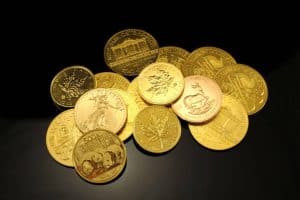Should You Transfer a Portion of Your Assets into Gold?
Investing in precious metals via an IRA is a great way to diversify your retirement portfolio. Choosing an IRA service is the first order of business. To fulfill your requirements, it is recommended that you seek out a business that deals only with precious metals.
 Following that, you will need to fill out an application and negotiate the terms with a representative from the company. A personal IRA allows you to save for retirement in a manner of your choosing. With a self-directed IRA, you have more freedom to diversify your investments across asset classes and route your money in any way you see fit.
Following that, you will need to fill out an application and negotiate the terms with a representative from the company. A personal IRA allows you to save for retirement in a manner of your choosing. With a self-directed IRA, you have more freedom to diversify your investments across asset classes and route your money in any way you see fit.
When opening a precious metal IRA, you must first decide on the metals you want to invest in. When collecting any foreign rounds, bars, or coins, be sure to check the legal tender status in your own nation. When purchasing precious metals, your IRA must allow a depository. There need to be no less than six such depositories from which to choose.
Self-storage IRA accounts are often misunderstood to be available to IRA owners. The IRS does not allow IRA accounts to directly send bullion to the holder for home storage. That is a misconception. Your broker, for example, BMOGAM Financial, will use an IRS-approved depository for bullion storage.

In what ways may I get started with a gold IRA?
If you’d want to put gold into your IRA, you may do it in a few ways. You may deposit funds into your account in several different ways, including cash, checks, and wire transfers, however, some of these methods may incur additional costs. You may self-fund, rollover another IRA or 401k into a precious metals IRA, or you may have been gifted resources from a spouse.
Direct account-to-account transfers take five business days and need a document from your account administrator. Yet, you will not have to pay any taxes or fees on the money you transfer. When it comes to investing, the great majority of people choose the direct transfer of funds option.
Learn from the IRS what you need to open a gold Individual Retirement Account.
The trustee will buy the metals on your behalf in any event. Anyone thinking about starting a gold IRA should do their due diligence and choose a reputable financial institution to handle the account on their behalf. Choosing a depository and a trustee is necessary when establishing a gold IRA, and IRS (https://www.irs.gov/retirement-plans/individual-retivice (irs.gov)) regulations are clear. In contrast to traditional IRAs, gold IRAs call for a transfer to a depository to be accessed.
Gold and silver are examples of precious metals that are commonly held as stores of value. Metals’ rising prices during market downturns are an efficient hedge against inflation and economic downturns. One may invest in precious metals in a few different ways that are accessible to the average investor.
First, you may purchase any kind of coinage, bullion, or bars of precious metal from a merchant. Putting money to work in this manner is the simplest option, but it also carries the greatest danger. Like equities and bonds, retirement accounts may invest in precious metals like gold and silver.
Stock in gold mining firms is another option for those looking to diversify their holdings into precious metals. Compared to the tried-and-true approach of acquiring actual metal, this more indirect form of investing may seem riskier.
Another kind of investment instrument is an agreement fund (ETF). Exchange-traded funds (ETFs) are stock market-traded mutual funds. As a result, investors may have exposure to a wide range of assets without having to buy each one separately.
Buying shares in a precious metals mutual fund is the fifth option to invest. Mutual funds and exchange-traded funds both provide investors with exposure to a wide range of assets (ETFs). Mutual fund investors, in contrast to ETF investors, are not required to acquire each underlying asset. Mutual funds are a specific kind of investment vehicle. Know more about ETFs here.
There are hazards associated with every precious metals investment method you choose, so it’s important to do your homework. The value of precious metals investments might rise or fall dramatically at any one moment.

Holdings in Rare Metals IRA
Investors may diversify their portfolios away from the typical stock market and bond market and into precious metals like gold, silver, and palladium via an individual retirement account (IRA) called a precious metals IRA.
There are two types of Individual Retirement Accounts (IRAs): the regular and the Roth. Contributions to a standard IRA are not taxed when made, unlike Roth IRAs, but are subject to taxation when the money is withdrawn in retirement. Roth IRAs are funded with after-tax monies, unlike normal IRAs, but withdrawals by account holders over 59 1/2 are tax-free.
Both standard and Roth IRAs allow for the holding of precious metals. Yet, there are several rules and restrictions to consider. In addition, the IRS stipulates that the metals must be stored in a depository recognized by the department. But there is a maximum amount that may be added to an IRA each year. If your workplace offers a precious metals IRA, you may roll over 401(k) assets.
Precious Metals ETFs allow investors to get market shares without owning the metals.
Also, ETFs may be held in a regular brokerage account and the procedure of purchasing and selling them is straightforward. Anybody interested in investing in gold, silver, or other precious metals now has a dynamic new alternative in the form of exchange-traded funds. On the other hand, its value might fall due to market volatility.
Exchange-traded funds (ETFs) may be risky investments, so it is important to do your research on potential ETFs and talk to a financial advisor to be sure the funds are right for you before putting money into them.
If you’ve followed the gold market, you know gold’s price has surged by nearly 400% in the last two decades. Because of this, gold may be a good choice for people looking to diversify their retirement savings. There are pros and cons to investing in gold, but many astute investors consider it a safe haven for their retirement savings.
Gold retirement investors may choose from a broad range of options, including stocks, gold-backed instruments, and physical gold. If you desire gold for your retirement, you should invest in physical gold. Putting actual gold in your retirement account is one of the oldest and most obvious ways to invest in gold. Investors buy gold from a dealer in the form of coins or bars. Notwithstanding appearances, thorough research and verification of the dealer’s credibility should precede any financial commitment.

